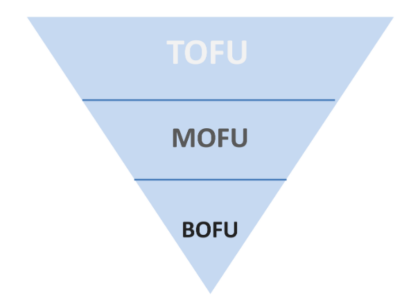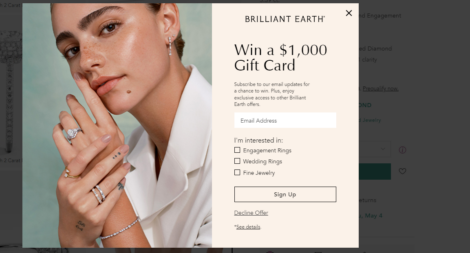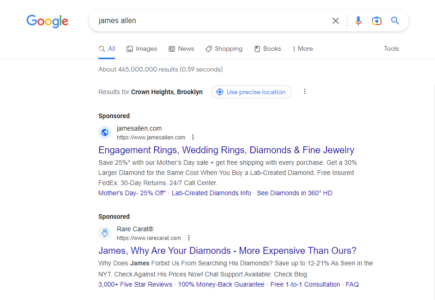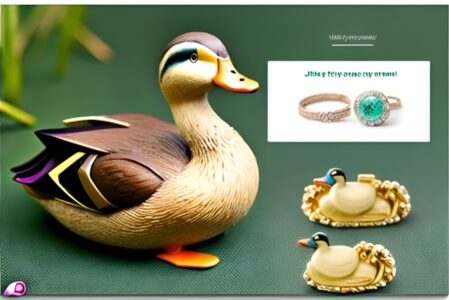Advertising Jewelry Online: 10 Jewelry Marketing Ideas to 3x Your Sales
Filed under:
Uncategorized
Comments:
Comments Off on Advertising Jewelry Online: 10 Jewelry Marketing Ideas to 3x Your Sales
Every day, more and more jewelers are shifting their focus from traditional advertising to digital marketing. However, advertising jewelry can be tricky when transferring to a digital realm. Unlike what some beginners to jewelry advertising think, it’s not just enough to run a few ads on Instagram and other social media and call it a day. It takes much more effort to attract foot traffic to your physical jewelry store with digital ads, and even more effort to do the same for your e-commerce jewelry store and properly analyze the results.
In this blog post, we are going to cover ten things to pay attention to when it comes to jewelry marketing. It’s not just a list of basic jewelry advertising ideas, it’s more of a blueprint to 3x your jewelry store sales: from top-level strategy on how to segment your campaigns to more precise tactics that will help your jewelry business succeed digitally.
Whether you already work with a jewelry marketing agency, plan to do it yourself, or are currently searching for one, you will be able to find some helpful ideas that have been proven to bring more conversions to our clients in the luxury and jewelry industry.
1. Take Into Consideration The Longer Purchase Cycle For Your Jewelry Store
High-priced items, such as jewelry, tend to have a longer purchase decision cycle. For example, over 90 days may pass between a customer discovering your jewelry brand online for the first time while searching for a diamond engagement ring and an actual purchase from your jewelry store, online or in-person.
What it means for you:
It is important to segment your jewelry advertising campaigns into three stages down the purchase decision funnel.

Top-funnel campaigns
- Target broad search terms (for example: “sell jewelry”, “buy jewelry”)
- Target in-market and affinity audiences for display and video (for example, jewelry and watches, fine jewelry, wedding and engagement rings)
At this stage, a prospective customer has a vague idea of what they want to buy, but is often not too sure about a specific product.
It’s better to educate a prospect at this stage rather than sell to them right away. For example, they want to buy an engagement ring, but there are so many options. Do they know the benefits of lab-grown diamonds? Are they sure about the shape of a diamond they want on the ring? Are they aware that you have one of the most competitive prices, along with one of the largest selections of jewelry among your competitors?
Mid-funnel campaigns
At this stage, your prospective customers are much more aware of what exactly they want, so they are looking for more specific terms and browsing more specific pages or websites (for example, more resources and pages about lab-grown diamonds as opposed to earth-mined).
Target more specific search terms, for example,
- Oval diamond 2ct engagement ring
- Lab-grown engagement rings
Since usually, at this stage, your prospects know more about what they want (or even know what they want exactly), they are most likely just looking for the best deal or the best brand to buy from. That’s why it’s important to emphasize your best brand qualities in the ads and landing/product pages at this stage and try to persuade them that your brand/your jewelry store is their best option for this specific jewelry piece they want to purchase.
Bottom-funnel campaigns
Here we go, congrats, you have reached the bottom level where a customer is about to make a purchase, but hold your horses, there is still more work to be done before this prospect becomes your regular customer!
We already discussed the importance of branding at the upper stages of the purchase funnel. At this stage, a prospect is already aware of your brand, but they may also want to explore your competitors for similar products and to see if they are better in some aspects such as customer service or faster delivery/pick-up time, compare pricing and so on.
Examples of bottom-level funnel campaigns may be:
- Branded search campaigns (when someone is searching for your brand, your ad would show up on the top of search results).
- Display and video retargeting campaigns (when somebody visits your website, they are served with a display, video, or text ad).
Track results properly
Be ready to analyze the results of your jewelry marketing campaigns over a longer conversion window.
Since the maximum conversion window for Google Ads and Google Analytics is 90 days, keep in mind that some top-of-the-funnel campaigns may not get the full credit they deserve. However, they are still essential.
Pay attention to attribution modeling to give proper credit to every channel on your customer’s journey. Compare different attribution models in GA4 to data-driven attribution.
If your jewelry marketing agency isn’t conducting essential segmentation of your campaigns and isn’t properly tracking results, perhaps you should consider saying “duck my marketing agency” and come to us.
2. Provide Extra Value

Purchasers of luxury and jewelry items like to get the most value for their buck, just like anyone else. Providing extra value can come in many forms:
- Monetary discounts:
“$150 off your purchase of any jewelry over $1,000”
- Gifts with the purchase:
“Pick any necklace from our “midnight jewelry” collection with any purchase over $100”
- Complimentary service with the purchase:
“Free shipping and handling on any online purchase of our jewelry this week only!”
At Duck Your Agency, when it comes to jewelry marketing, we always see a decent spike in transactions and other conversions when our search and display ads and client websites feature a promo or an extra value message. The uplift in conversions can be as high as 200% compared to the time periods when no such promo or extra value message was in place.
3. Target Your Competition (Especially Bigger Jewelry Brands)

In the picture above, we see Rare Carat targeting James Allen keyword, simultaneously trolling them “James, Why Are Your Diamonds More Expensive Than Ours?” You can do it too!
Big brands spend millions of dollars on jewelry advertising online. Take advantage of the multimillion-dollar budget of your competitors (especially bigger jewelry brands) and advertise to prospects looking for them online!
It’s a great chance to get customers who are lower in the purchase decision funnel for a lower price!
You can also run display and video ads on Google targeting users who recently visited your competitors’ websites or similar sites in the luxury & jewelry industry!
It’s important to remember not to use your competitors’ brand names in your ad copy. This practice is against Google Ads policy and also unethical, as it can confuse potential customers who might mistake your ad for another jewelry store’s website. Instead, emphasize your business/brand name in your ads to avoid any confusion.

4. Experiment With All Kinds Of Retargeting
Visuals play an important role in jewelry marketing, and the purchase decision cycle is long (as we discussed earlier). Therefore, it’s critically important to expose your potential buyers to all sorts of remarketing ads to keep your business top of mind during the purchase cycle.
There are several types of retargeting ads that you can incorporate into your jewelry digital marketing strategy, such as:
- Static display ads
- Dynamic product display ads
- Responsive Display Ads (Google Display Network)
- Native ads
- Video remarketing ads
It’s important to A/B test visuals and messaging from time to time to see what’s working the best for your store.
Keep in mind that some of the retargeting activities are hard to track, since it involves view-through conversions (when a prospective customer saw your ad, but didn’t click on it), cross-browser and cross-device activity. It also takes some time to see and attribute the results (especially with longer purchase cycles, such as luxury & jewelry items).
We recommend data-driven attribution in Google Analytics 4 to get a glimpse on your retargeting campaign performance.
For example, we have been running a general branded video retargeting campaign for one of our jewelry store marketing clients to increase brand awareness during and in between purchase cycles.
We didn’t see much traction in the beginning, but then the data-driven attribution started to show that many users were exposed to our video remarketing ad during their decision cycle before converting.
Below is an excerpt from conversion paths of the client. As you can see, a few users were exposed to our video retargeting ad in the middle of their purchase decision cycle before converting.

5. Focus On Getting Customers To Visit Your Store And Building Strong Client Relationships, Rather Than Solely Emphasizing Quick Online Purchases
Consumers prefer in-person interaction when buying high-ticket items such as expensive jewelry pieces.
Many local customers prefer to make a transaction and have a final glance at a desired item in-person at your jewelry store.
If it’s a national e-commerce customer, a lot of them prefer some kind of human interaction over chat or phone to get their questions, concerns, and special requests answered before giving you their credit card number.
Therefore, to get a full picture, you have to track all the micro-conversions that led to in-store or online purchases. Here are some ideas for jewelry business micro-conversions:
Website conversions for an online jewelry store:
- Call from your website was initiated.
- Online Chat with a rep started.
- Contact us (or any lead form) was submitted.
- Directions page was viewed.
Local actions (Google maps) conversions:
- Requested directions to your store.
- Called from Google maps.
- Other actions (saved to favorites, starred, etc.).
- Visited your website if your jewelry store from Google maps.

6. Attractive Images And Product Descriptions Are Must To Increase Sales
Compelling product descriptions and multiple professional images of your products are a must-have feature of any jewelry e-commerce store. Not only will this differentiate you from your competitors and help customers make purchase decisions, it will also boost your SEO, search ads, and shopping ads. Titles and descriptions impact quality score, and Google pulls keywords directly from titles and descriptions in Google Shopping ads.
It seems like a no-brainer, but if you have hundreds or thousands of SKUs it can be a pretty daunting and time-consuming task to complete. But, trust us, it is well-worth time and effort. We saw a dramatic increase in conversions for our jewelry marketing clients that went from generic descriptions and poor quality product pictures to compelling descriptions and beautiful pictures for each SKU.
Let’s take a look at these two examples of a product description for an engagement ring:
Generic version:
Solitaire Semi-Mount Engagement Ring in 14 Karat White with 0.01Ct, RO Sapphire Ring Size: 6.5
More compelling and attractive description of the same ring:
Introducing our stunning Solitaire Semi-Mount Engagement Ring, crafted with precision and care from high-quality 14 Karat White Gold. The centerpiece of this gorgeous ring is a sparkling 0.01Ct RO Sapphire, known for its exquisite deep blue hue and superior clarity. The ring is available in a perfect size 6.5, and the semi-mount design allows for easy customization with your preferred diamond or gemstone. From the gleaming white gold band to the vibrant sapphire centerpiece, every detail of this ring exudes luxury and sophistication. Perfect for the love of your life, this Solitaire Semi-Mount Engagement Ring is sure to make a lasting impression and capture her heart forever.
The latter description is not only more attractive and likely to generate more conversions, but it also includes several additional keyword variations that can improve your search engine optimization (SEO) results and enhance your Search and Shopping ads.

7. Set-up Advanced Email Marketing and CRM Integration
Cleverly set-up email marketing can be a great tool to stay top of mind with prospective customers during the long purchase decision cycle. Consider three rules for email marketing and CRM integration: email capturing, segmentation, personalization, and automation.
Capture emails of new visitors right away with cleverly designed pop-up offers. For example, “Submit your email to get 5% off your first jewelry purchase online.”
Segmentation allows you to tailor your messaging to each group, increasing the relevance of your communications and improving engagement rates. In the case of a jewelry website, potential segmentation lists might include:
- Purchase history: Customers who have made multiple purchases vs. those who have only made one
- Product category: Customers who have purchased only engagement rings vs. those who have purchased other types of jewelry
- Price point: Customers who have made high-value purchases vs. those who have made lower-value purchases
8. Add Videos To Product Pages or Key Landing Pages
Consider adding videos to your product pages or key landing pages to boost conversion rates and improve SEO. Search engines like Google view video content as high-quality and engaging, making it an effective tool for attracting more visitors and improving search engine rankings.
Creating a high-quality video for every jewelry piece can be expensive, so instead, you might consider creating a video for each category or a landing page. Doing so can help increase organic search rankings and benefit paid search as well.
In addition, you will also have a lot of video content that you can use for display prospecting and retargeting campaigns, video prospecting and retargeting campaigns, social media campaigns and more!
9. Enable Local Inventory Ads with Delivery and Pick-Up Times and Pick-Up Today Options

It is important to advertise all available delivery and pick-up options in Google Shopping, especially for local jewelry marketing. Many customers prefer to know that the item they like is available in-store, so even if they do not purchase online, they can visit the store in-person to see the item before buying.
To display delivery and pick-up times, as well as the option to “pick-up today,” you must enable local inventory ads and create a local inventory feed, in addition to the main product shopping feed that you may already have. The local inventory feed includes information about your inventory levels and local availability. You can set up delivery and pick-up options in the “Local Inventory Ads” section of your Google Merchant Center account.

10. Focus On On-Site Conversion Optimization
Just like with any other industry, conversion optimization is an inevitable part of jewelry advertising and marketing. Here are a few techniques to start with to improve your website conversion rate:
- A/B test different messaging, promotions, and delivery methods.
At Duck Your Agency, we were able to increase email sign-ups and online orders by 15-30% by testing different messages, images, and techniques. For example, we experimented with exit-prevention and regular pop-ups, overlays on top or bottom of websites, creating an urgency vs. regular message (such as a time counter letting potential customers know that the deal expires soon vs. a regular non-timed offer), and more.
- Add a web chat and A/B test different prompts to start a conversation.
Experiment with how web chat and different chat prompts affect conversions. A/B test prompt messages.
- Add social proof to landing and product pages.
Adding the ability for customers to review products and businesses can help increase sales. If there are not enough reviews for each SKU, you can add general reviews for the business or product categories. Test the placement of the reviews on product pages and landing pages and see how it affects conversions.
- Optimize the checkout process and steps before a customer makes an appointment.
Minimize the number of steps before a purchase or form submission, A/B test different forms, test multi-step forms, offer help at checkout, or ask if there are any questions via a chat prompt – these are just a few ways to optimize conversions for your jewelry business.
Author: Sergey Izbash
Ducking Marketing Genius & Founder @Duck Your Agency
P.S. Looking to increase conversions for your business in the luxury & jewelry industry? Maybe it’s time to say “duck my marketing agency” and come to us! Fill out the form below and let’s chat:

 Your Underperforming Digital Marketing Agency
Your Underperforming Digital Marketing Agency





